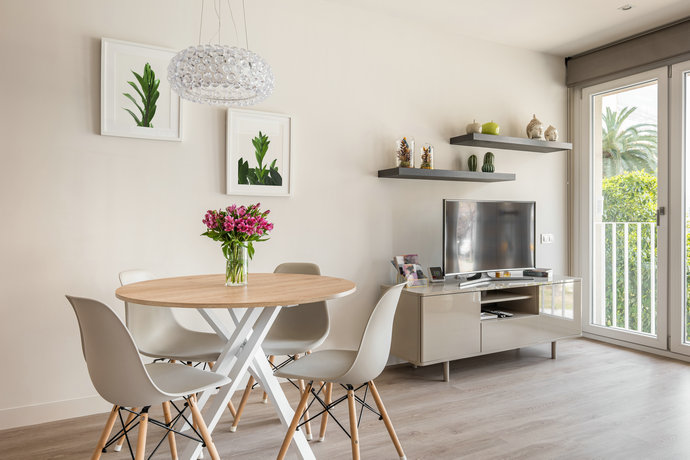
In the heart of every home lies a gathering point, a place where meals are shared, conversations spark, and memories are made: the dining table. Yet, for such a central piece of furniture, many homeowners remain uncertain about one crucial detail: the standard height of a dining table. Ensuring that your table stands at the appropriate height is not merely about aesthetics; it also affects comfort, function, and the overall dining experience. This guide is dedicated to demystifying standard dining table heights, helping every homeowner make informed decisions for their dining spaces. Whether you’re purchasing a new table or assessing your current one, this guide will ensure your dining area is both stylish and ergonomically sound.
What is the Standard Dining Room Table Height?
The industry standard measurements for a dining room table height fall between 28 and 32 inches (71 to 81 centimeters) tall. This height is designed to work well with chairs, stools, and benches that range from 18 to 23 inches in height. These dimensions ensure a comfortable and ergonomic sitting position while enjoying your meal.
It is worth noting that there are also counter-height dining tables available, which typically measure around 36 inches (91 centimeters) high. These tables are more informal and often used in kitchen or open-plan settings, where they can complement existing countertops or kitchen islands.
So, when choosing a dining table, it’s essential to keep these standard measurements in mind. This will not only offer comfortable seating but will also make it easier to find matching chairs or other seating options.
Placing your dining table in an area that allows for at least 36 inches (91 centimeters) of space between the table and walls is another important factor to consider. This ensures that there’s ample space to move around the table and create a pleasant dining experience.
How Do You Pick the Right Size Dining Table?
When choosing the perfect dining table for your space, it’s essential to consider the size and shape of the table to ensure it fits well and comfortably accommodates everyone. Here we’ll explore the ideal sizes for round, square, and rectangular tables.
Size of Round Tables
Round tables create a cozy atmosphere and allow for easy conversation, as everyone is an equal distance apart. To determine the appropriate size for your round table:
- A table with a diameter of 48 inches can accommodate 4 people
- A table with a diameter of 60 inches can accommodate up to 6 people
Remember that you should also allow for at least 3 feet of clearance around the table for chairs and movement.
Size of Square Tables
Square tables offer a balanced and symmetrical look, making them a great choice for smaller dining areas. Here are the standard sizes for square tables:
- A 48-inch square table can comfortably seat 4 people
- A 60-inch square table can accommodate up to 8 people
Remember to factor in at least 3 feet of space around the table for chairs and walking room.
Size of Rectangular Tables
Rectangular tables are the most common choice for dining tables, as they can easily fit into various room layouts. To choose the right size for a rectangular table:
- Measure the length and width of your dining area
- Allow for 42 to 48 inches of space between the table and the walls or other furniture
- If your dining space is more extensive, consider a wider table to fill the room proportionately
A general guideline for seating capacity is:
- A 60-inch long table can accommodate 4 to 6 people
- A 72-inch long table can seat 6 to 8 people
- Tables over 72 inches long can seat 8+ people, depending on the width of the table
Different Height Types

Counter Table Height
When choosing furniture for your home, it’s essential to consider the different height options available. Counter-height tables typically measure between 34 and 36 inches (86-91 cm) tall. These tables are perfect for creating a casual dining experience and are often used in kitchen or bar areas. Paired with stools or counter-height chairs, these tables provide a comfortable space for quick meals or gatherings with friends and family. If you’re looking for a taller and more informal option, bar height tables could be a great choice. These tables usually stand between 40 and 42 inches (102-107 cm) tall and are often seen in pubs, bars, and casual dining establishments. Bar-height tables work best with bar stools, providing a relaxed atmosphere for socializing and enjoying drinks or small meals.
Dining Table Height
Standard dining table heights generally range from 28 to 30 inches (71-76 cm). This height accommodates a wide range of chair sizes and provides a comfortable dining experience. Standard height tables work well for families with members of various ages and mobility levels. When selecting a dining table, consider the dimensions of the room and the space you have available to ensure a comfortable fit.
Coffee Table Height
Finally, coffee tables are an essential piece of furniture in many living rooms. They usually have a height of 16 to 18 inches (41-46 cm), making them lower than standard dining or counter-height tables. Coffee tables are designed to be the perfect height for resting drinks or snacks, and they work well in combination with sofas and lounge chairs for a cozy and inviting feel.
How to Choose the Right Table Height?
Choosing the ideal dining table height for your needs can significantly enhance your comfort and the overall dining experience. In this section, we will discuss how to select the right dining table height while taking into consideration different factors like chair height, the purpose of the table, and the occasions on which it will be used.
The Height of Your Chairs
When selecting a dining table, it’s crucial to consider the height of the chairs you plan on using. The standard chairs have a seat height of around 18-23 inches. Ensuring that there is enough legroom for people sitting at the table is an essential aspect of comfort. If you already have chairs or are purchasing a dining set, look for a table that complements the chair height to ensure a pleasant dining experience.
How Are You Going to Use This Table?
The intended use of your dining table should dictate the height you choose. For instance, dining room tables are generally designed to be higher than kitchen or breakfast nook tables. If you require a more formal dining room table, look for one around 30 inches in height. If your table will mainly be used for casual meals such as breakfast or, in spaces like breakfast nooks and small kitchens, a slightly lower table at 28 inches might suffice.
Table for Special Occasions
Another consideration when choosing the right table height is whether the table will be used during holidays, large gatherings, or special events. Formal settings might call for a standard table height of around 30 inches, while more informal gatherings can accommodate a lower table height. If you frequently host a variety of events, consider looking into manufacturers that offer adjustable height tables to suit different occasions and seating arrangements.
How Much Space is Needed for a Dining Table and Chairs?
When planning your dining area, it’s essential to consider how much space you’ll need for your dining table and chairs. You want to ensure that there’s enough room for you and your guests to comfortably sit, eat, and interact. Let’s explore some key factors to consider.
First, consider the size of the dining table. Standard dining tables measure about 28 to 30 inches high, but they also vary in width and length depending on the number of people you plan to seat. For example, a four-person table typically measures 36 inches wide by 48 inches long, while an eight-person table could be 36 inches wide by 78 inches long.
Next, think about the space around the table for chairs. A good rule of thumb to follow is to allow at least 24-30 inches between chairs. This ensures that everyone has ample room to sit and move around without feeling cramped.
Aside from the table and chairs, consider how much additional space you’ll need to navigate your dining area. It’s a good idea to leave about 3 feet between the table and a nearby wall or other furniture. This allows you to move around freely, place settings, and serve food comfortably.
Finally, it’s important to plan for the overall dimensions of your dining room. For example, if you’re accommodating a six-person table, a room width of 8 feet 10 inches x length of 10 feet should be sufficient. Meanwhile, for a larger dining arrangement with clearance for ten to twelve people, a room measuring 15 feet wide x 20 feet long will likely function better.
The Effect of Shape on Dining Tables
Oval Tables
When it comes to oval tables, they offer a unique combination of the intimacy of round tables and the roominess of rectangular tables. The shape of the table allows for easy conversation, and the proportion of the table ensures that there is ample space for you and your guests.
Most oval dining tables are between 28-32 inches or 71-81 centimeters in height, allowing for an ergonomic and comfortable seating arrangement. To ensure everyone has enough legroom and comfort, make sure to choose chairs with seat heights of 18-23 inches.
Square and Rectangular Tables
Square and rectangular tables are the most common dining table shapes and provide ample space for a variety of chair arrangements. The standard height for these tables is also 28-32 inches or 71-81 centimeters, making it easy to find chairs that match the height of the table comfortably.
In larger rooms, you can add leaves to extend your table to accommodate even more guests. Keep in mind the proportion of your table when selecting countertops, ensuring there’s enough space for your chairs and the comfort of your guests.
Here’s a quick guide to chair heights and table sizes:
- Standard-height tables: 28-32 inches (71-81 centimeters)
- Standard chair seat heights: 18-23 inches (46-58 centimeters)
In summary, when choosing a dining table shape, consider the proportion and ergonomic comfort it offers. Oval tables provide a unique balance between round and rectangular tables, while square and rectangular tables offer versatility and roominess. Ensure you select the right chair heights to match your chosen table for maximum comfort.
Frequently Asked Questions
What’s the ideal distance between a table and the chairs?
When arranging your dining room setup, it’s important to leave enough space between the table and chairs for comfortable seating and movement. The ideal distance between a table and the chairs should be about 36 inches. This allows enough space for people to sit, stand, and move around comfortably.
How tall should a dining table be for a 6 seater?
The standard height for a dining table is typically between 28-32 inches (71-81 centimeters). This height range provides the most ergonomic seating arrangement for various activities such as eating, working, or socializing. So, whether you have a 6-seater dining table or a smaller size, this height range remains ideal.
What’s the difference in height between a dining table and a counter table?
While dining tables generally have a standard height of 28-32 inches, counter tables are slightly taller, with a height range of 34-36 inches. Counter tables are designed for use with counter-height chairs or stools and provide a more casual, relaxed eating or working environment compared to a standard dining table.
What is the average height of a dining chair?
The average height of a dining chair, specifically the seat height, ranges from 18-23 inches. This height ensures a comfortable position and matches well with the standard dining table height of 28-32 inches.
Are there guidelines for table and chair heights?
Yes, there are guidelines to help you choose the right table and chair heights for your dining setup. For a comfortable seating arrangement, match standard dining table heights (28-32 inches) with dining chairs that have seat heights of 18-23 inches. For counter-height tables (34-36 inches), use counter-height chairs or stools with seat heights between 24 and 26 inches.
How do dining table dimensions vary for different settings?
Dining table dimensions depend on factors such as the number of seating spaces, room size, and personal preferences. Standard dimensions are based on common furniture sizes and the need for comfortable seating and legroom. For example, a four-seater dining table usually has a width of at least 36 inches and a height of around 31 inches. In larger settings, table dimensions will increase to accommodate more seating, but the height range remains standard at 28-32 inches.






